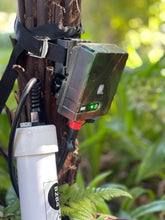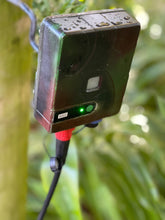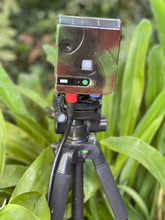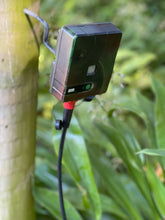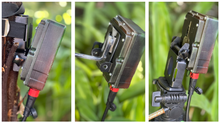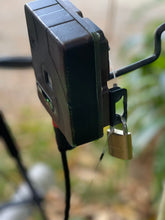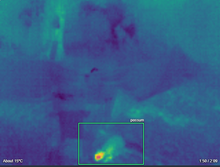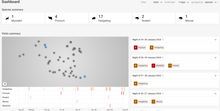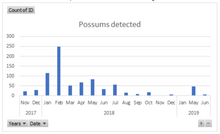
The Thermal Predator Camera automatically detects movement and uploads videos to the cloud where they are analysed using machine vision algorithms to detect predators and birds.
The videos and statistics on the animals found can be viewed on the cacophony portal.
This provides the easiest, most effective and most cost effective way of monitoring predator numbers. These claims are backed up by the results from a Lincoln University study into the effectiveness of these thermal cameras. This study showed that these cameras are
- 3.5x more sensitive than infrared trail cameras for possum detection
- 200x faster to analyse
- 8x cheaper per detection (this was calculated when the cameras were over twice the price)
Another study showed that the cameras are 5-20 times more sensitive for detecting rats.
The Department of Conservation have published a paper comparing thermal and trail cameras. This looks at the total cost of ownership and recommends situations where one type of camera should be used over the other. This study was done using the higher priced camera. This lower priced camera will broaden the situations where it is economic to use the thermal camera.
At the moment the model can automatically identify:
- possums
- rodents (rats and mice)
- cats
- hedgehogs
- mustelids (stoats, ferrets and weasels)
- birds
- leporidae (rabbits and hares)
- wallabies
- penguins
- vehicles.
- humans
The accuracy of the identification varies with distance of the animal from the camera. Generally there is very high accuracy from 3-8m. This article describes the accuracy of the thermal camera machine vision in more detail.
This thermal camera can work online or offline. If the camera is within cell phone coverage and has a modem then the videos will be uploaded to the cloud as they are recorded. If the camera is not within cell phone range, or the there is no modem then the videos are stored on the camera and will be uploaded, either when the camera is bought back into cell phone reception or WIFI, or they can be wirelessly transferred from the camera to a phone using app called sidekick (read more about sidekick).
The camera includes a year's worth of cloud storage. Additional storage and connectivity can be bought separately. This video shows what it's like to use the Cacophony Portal.
The camera can be powered by a battery, mains power supply, or solar. The power supply, batteries and charger are each sold separately. The camera can operate in two power modes:
- High power mode, where videos are uploaded to the cloud immediately. This is useful if you need a real-time alert of a predator. The camera can be configured to send you alerts when certain predators are detected. On average a battery will last 11-13 nights on High power mode and 6-7 nights if the camera is configured to record all day.
- Low power mode, where videos are uploaded only once/night. This provides approximately 3x the battery life: 33-39 nights.
If you want to use solar to power the camera this can be set up using off the shelf components. This document describes a solar set up for the thermal camera. We will shortly be providing a lower cost solar solution that is works with low power mode.
The camera can be mounted by strapping it to a tree (strap is included), attaching it to a screw spike (spike included), or mounting it to a tripod. The camera can easily be secured with a lock (not included).
There are regular software updates for the camera, providing software fixes and new functionality. The camera contains a microphone that is not currently used. Eventually it will be able to be used to take audio recordings to monitor bird populations. The camera also contains an auxiliary port that has the capacity to drive a speaker, or connect to a communications network (the functionality for this has not been developed yet).
"I really appreciate the ongoing tech support and modifications you’re providing to our team. It is hugely valued and a great comfort when spending up large (for conservation budgets) on new tech tools." Matt Maitland, Senior Ranger Open Sanctuaries
Try before you buy
We have an option to rent the cameras. If you elect to buy rather than return then we will credit the rental cost towards the purchase of the camera. This is a great, low risk way of working out if the camera meets your needs.
Upgrade
To those of you who have bought the first version of our cameras, we offer a low cost upgrade. Check out the packages to upgrade your camera.
Specifications
| Specification | |
| Operating voltage | 5-13.3V (battery or mains) |
| Sensor |
FLIR lepton |
| Field of view | 56° HFOV, 71° diagonal |
| Resolution | 160 x 120 |
| Frame rate | 9 Hz |
| Range |
~10-20m |
| Connectivity |
Modem or Wi-Fi |
| Storage | 32GB |
View the thermal camera accessories.
Download the thermal camera manual.
Check out blog posts about the thermal camera and videos about and from the thermal camera
Here is a a draft protocol for how to use the thermal cameras to monitor predators over an area. We recommend about one camera every 4 hectares for monitoring.
The camera hardware and software, along with the machine vision algorithms and cloud storage portal have all been developed by The Cacophony Project, a not for profit organisation. A proportion of the proceeds will be donated to The Cacophony Project so they can continue to develop technology to help New Zealand become predator free.








